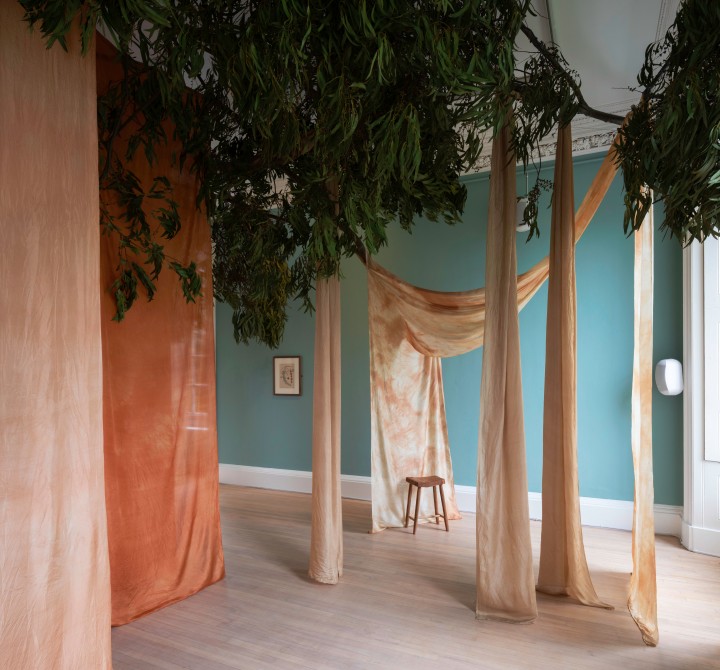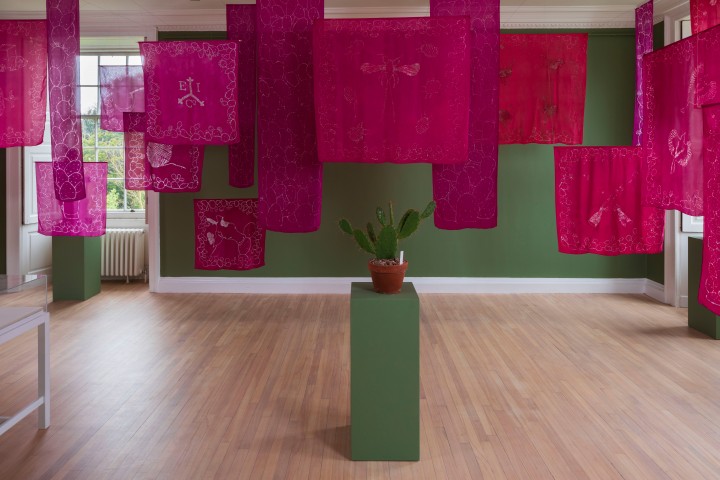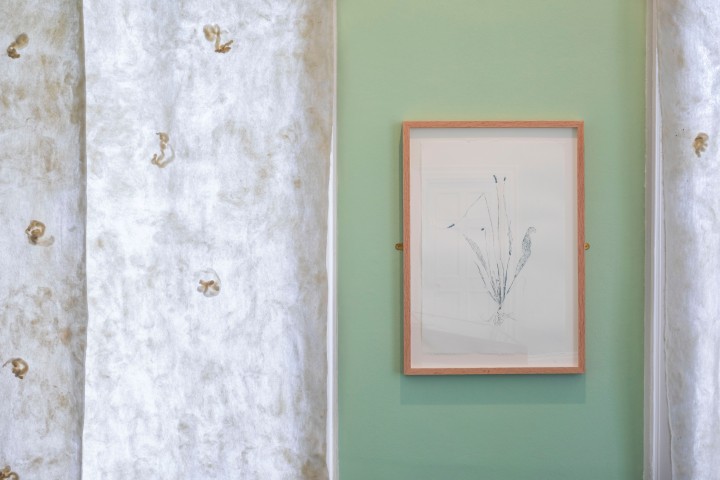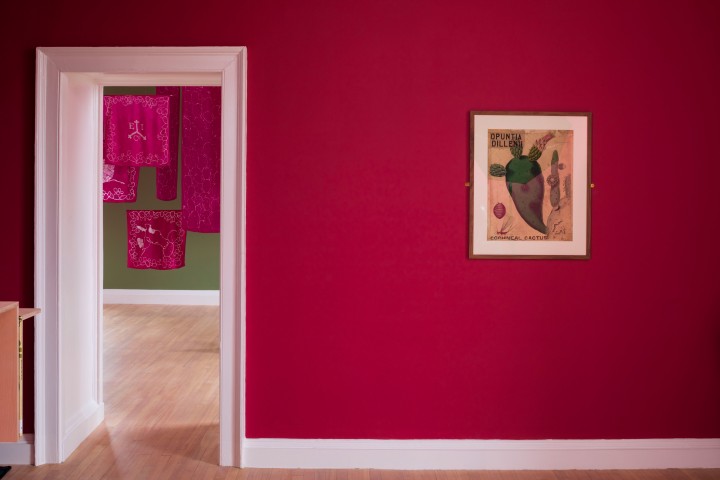Scottish Art News
Latest news
Magazine
News & Press
Publications
Keg de Souza: Shipping Roots
By Greg Thomas, 03.05.2023

Blowing in the Wind
Keg de Souza’s Shipping Roots, at Climate House in Edinburgh, uses multi-sensory installations to tell the stories of plants transported around the globe with our colonial ancestors. Greg Thomas reviews.
The heady scent of eucalyptus fills a downstairs gallery at Climate House in Edinburgh’s Botanic Gardens. Great sheaves of eucalyptus branches are hanging from the ceiling, surrounded by drapes of terracotta-coloured silk that have been dyed with extracts from the same plant, while a soundtrack tells the story of this hardy genus’ spread around the world, splicing the voices of ecologists, botanists, and a 100-year-old Bigambul elder. This is ‘Blue Haze’, one of several multi-sensory installations created by Goan artist Keg de Souza for her summer show Shipping Roots (the work takes its name from the blue mist that hangs in the air around eucalyptus plantations, created by plant-oil mingling with dust particles and water).
 Keg de Souza, Green Hell, 2023. Installation view in Inverleith House, Royal Botanic Garden Edinburgh. Photo: Ruth Clark.
Keg de Souza, Green Hell, 2023. Installation view in Inverleith House, Royal Botanic Garden Edinburgh. Photo: Ruth Clark.
De Souza’s exhibition delves into the histories of various plants with connections to the artist’s current home-country of Australia. These species have become entangled with stories of colonisation, warfare, and global trade over the centuries, enmeshing themselves in worldwide ecosystems with often devastating results. Upstairs, another installation, ‘Green Hell’, uses a combination of hanging fabrics, botanical sketches, and live specimens to tell the story of the Prickly Pear, a cactus introduced in Australia as a habitat for the cochineal insects that were harvested to dye military uniforms. Across the way on the ground floor, ‘Fleece Fugitives’, with its beautiful cyanotypes and woollen curtains muffling the light, considers how seeds inadvertently shipped from Australia to Britain in sheep’s pelts birthed strange, exotic micro-forests around the woollen mills of Scotland.
 Keg de Souza, Fleece Fugitives, 2023. Installation view in Inverleith House, Royal Botanic Garden Edinburgh. Photo: Ruth Clark
Keg de Souza, Fleece Fugitives, 2023. Installation view in Inverleith House, Royal Botanic Garden Edinburgh. Photo: Ruth Clark
At the heart of this show is de Souza’s meticulous research, distilled into three mind-maps handwritten on bifurcated Perspex sheets that enclose further plant specimens. We learn how the British exported Eucalyptus from its Aboriginal homelands to India, where it was feted as the world’s fastest-growing durable hardwood. This has led, across the intervening centuries, to increased wildfire risk – the tree burns very easily – and lowering water-tables. The Prickly Pear, meanwhile, infamously became a pest species (or genus, strictly speaking) in Australia, swallowing up vast swathes of farmland to create the so-called “Green Hell” until the Argentinian Cactoblastis cactorum moth, whose larvae eat the plant, was introduced in 1926. Many of the fleece-fugitive seeds, like the pirri pirri bur, propagated after escaping with the water-borne run-off or “shoddy” from Scottish mills, and now cover whole stretches of the British coast.
 Keg de Souza, Green Hell, 2023. Installation view in Inverleith House, Royal Botanic Garden Edinburgh. Photo: Ruth Clark
Keg de Souza, Green Hell, 2023. Installation view in Inverleith House, Royal Botanic Garden Edinburgh. Photo: Ruth Clark
These are fascinating stories. Indeed, one might question whether the artworks de Souza has created step out of the shadows of these narratives to offer something extra: a moment of aesthetic pleasure or intensity extending beyond our encounter with the plants themselves; a conceptual motif that lingers in the mind as much as the stories the plants themselves tell. Still, an engaging visit.
Shipping Roots by Keg de Souza is exhibited at Climate House at the Royal Botanic Gardens Edinburgh until 27th April




